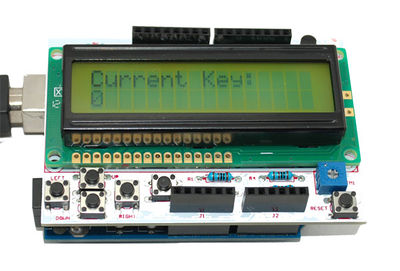16 X 2 LCD Keypad Shield for Arduino
Contents
Introduction
LCD keypad shield for Arduino operates at 5V.
- Includes a 2x16 LCD display and 6 momentary push buttons
- Use digital pins 4, 5, 6, 7, 8, 9, 10, and analog pin 0 to interface with the LCD
- Do not use Pin 10 while this shield is connected
- LCD color is green.
The LinkSprite 16 X 2 LCD Keypad Shield for Arduino includes a 2x16 LCD display and 6 momentary push buttons. Pins 4, 5, 6, 7, 8, 9 and 10 are used to interface with the LCD. Analog Pin 0 is used to read the pushbuttons. The shield operates at 5V.
Note: all new LCD shields with paper enclosure use pin 10 as brightness control.
Model:LCD_16_2_SHIELD
Features
- 16x2 LCD using HD44780-compatible display module (white characters on blue background).
- 5 buttons on one analog input (A0).
- LCD backlight with current limiting, brightness and on/off controllable by D3, can be moved to D2, D10, A1, A2, A3, A4 or A5 for easy project pin compatibility.
- Recessed LCD, panel mount screw holes and button layout suitable for panel or cabinet mounting if desired.
- Reset button.
- Power supply smoothing capacitor.
- Pins used by shield clearly marked, LiquidCrystal library setup reference is on the bottom of the pcb for convenience.
Application Ideas
Cautions
The warnings and wrong operations possible cause dangerous.
Schematic
Specification
Pin definition and Rating
Mechanic Dimensions
Usage
Hardware Installation
Programming
FAQ
Please list your question here:
Support
If you have questions or other better design ideas, you can go to our forum to discuss or creat a ticket for your issue at linksprite support.
Resources
- PDF Files
- ZIP Files
How to buy
See Also
Other related products and resources.
Licensing
This documentation is licensed under the Creative Commons Attribution-ShareAlike License 3.0 Source code and libraries are licensed under GPL/LGPL, see source code files for details.
